What's the value of W for the process ab following path 1 (a to b) and for the same process following path 2 (a to d, d to b), shown in the P-V diagram below?

Text Solution
Path 1: Since, in path 1, P remains constant, the work done is just PΔV.
W=PΔV=(1.5×105Pa)[(30×10−3m3)−(10×10−3m3)]=3,000J
Path 2. if the gas is brought from state a to state b, along path 2, then work is done only along the part from a to d. from d to b, the volume of the gas does not change, so no work can be performed. the area under the graph from a to d is
W=12h(b1+b2)=12(ΔV)(Pa+Pd)
=12(20×10−3m3)[(1.5×105Pa)+(0.7×105Pa)]
=2,200J
As this example shows, the value of W depends not only on the initial and final states of the system, but also on the path between the two. in general, different paths give different values for W.
|
Topper's Solved these Questions
- HEAT AND THERMODYNAMICSBOOK - PRINCETONCHAPTER - HEAT AND THERMODYNAMICSEXERCISE - COMPREHENSIVE DRILL
10 Videos
- CURVED AND ROTATIONAL MOTIONBOOK - PRINCETONCHAPTER - CURVED AND ROTATIONAL MOTIONEXERCISE - COMPREHENSIVE DRILL
11 Videos
- KINEMATICSBOOK - PRINCETONCHAPTER - KINEMATICSEXERCISE - MCQ
9 Videos
Similar Questions
Knowledge Check
A cyclic process is shown in the P−T diagram. Which of the curves show the same process on a P−V diagram ?
 A
A B
B C
C D
D
A cyclic process ABCA is shown in the V−T diagram process on the P−V
 A
A B
B C
C D
D
A cyclic process ABCA is shown in the V−T diagram process on the P−V
 A
A B
B C
C D
D
A cyclic process ABCA is shown in the V - T diagram . Process on the P – V diagram is

View SolutionA cyclic process ABCA is shown in the V - T diagram . Process on the P – V diagram is

View SolutionA cyclic process is shown in the p – T diagram . Which of the following curves shows the same process on the p – V diagram ?

View SolutionA cyclic process is shown in the p – T diagram . Which of the following curves shows the same process on the p – V diagram ?

View SolutionOne mole of an ideal gas is taken from a to b along two paths denoted by the solid and the dashed lines as shown In the graph below. If the work done along the solid line path is Ws and that along the the dotted line path is wd, then the integer closest to the ratio wd/ws is

View Solution

